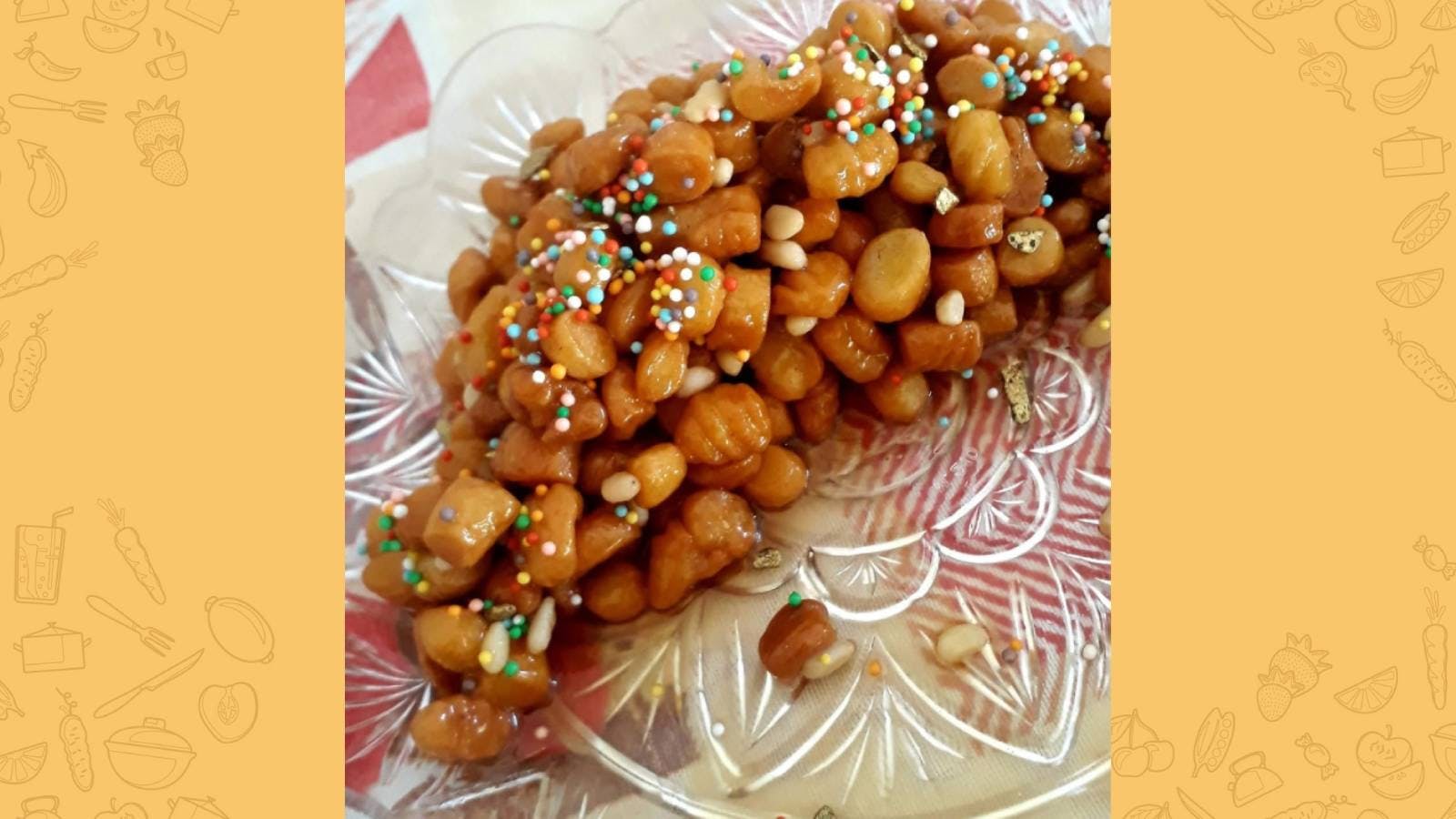

Unfortunately, like all good things, this magical time of year is coming to an end. To cheer ourselves up a bit, we want to share with you the recipe for a very special dessert typical of Apulia: Purcidduzzi. Our Cesarina Francesca from Copertino shows us how to prepare this Christmas treat, the true star of Apulian tables from the Feast of the Immaculate Conception until Saint Anthony’s Day on January 17.

“Preparing Purcidduzzi is already a celebration: days dedicated to making, frying, caramelizing with honey, and decorating in the most imaginative and creative ways. Children play a key role in shaping the small pieces of dough and, above all, in decorating the final dish. I remember my grandmother, a skilled seamstress, letting me shape them with her beloved thimble! Every family, every housewife, or cooking enthusiast has their own recipe, and this one is mine!”

Purcidduzzi (Italian Christmas cake)
Bite-sized treats covered in honey, typical of Christmas in Apulia
Ingredients
- 500 g of all-purpose flour
- 500 g of re-milled semolina flour
- 200 g of extra virgin olive oil
- 250 g of anise liqueur
- Juice of oranges and mandarins
- Citrus peels to taste (oranges, mandarins, lemons)
- 1 kg of acacia or wildflower honey
- Decorations to taste (almonds, pine nuts, colored sprinkles)
Method
- Heat the oil with the citrus peels (avoiding the white pith) in a small pan. Turn off the heat and let cool.
- Meanwhile, mix the two types of flour on a work surface. Add the grated citrus peel from the juice, pour in the oil, and start kneading. Add the anise liqueur and citrus juice, and knead until a soft, homogeneous, but firm dough forms.
- Let the dough rest while you organize the next steps. Take a portion of the dough and roll it into a rope about 1 cm in diameter. Cut into small pieces and roll them on the prongs of a fork (or on a grater or gnocchi board).
- Place them on a tray sprinkled with a little semolina.
- If desired, you can create other shapes like diamonds, bows, or rings—let your imagination run wild!
- Fry the dough pieces in plenty of oil for a few minutes.
- Once all are fried, warm half the honey in a large pot. When the honey begins to boil, add the purcidduzzi and gently stir. Add the remaining honey.
- After a few minutes, they are ready to be served on plates.
- Decorate as desired and let cool.
The Feast of the Befana: a truly Italian celebration
For Italian children, January 6 means one thing: the arrival of the Befana. Riding her broomstick, this old woman with a hooked nose and pointy chin, dressed in a patched skirt and worn-out shoes, flies through the skies and climbs down chimneys to fill children’s stockings with toys or coal, depending on whether they behaved well or poorly over the past year.
It is a distinctly Italian holiday, so much so that in other countries—not even far from us, like France—the tradition of hanging stockings doesn’t exist, and January 6 isn’t even a public holiday.
A figure between pagan and christian worlds
In christian tradition, the story of the Befana is closely tied to the Three Wise Men. Legend has it that on a bitterly cold winter night, Balthasar, Caspar, and Melchior, unable to find their way to Bethlehem, asked an old woman for directions. She showed them the way, and the Magi invited her to join them, but she refused. Shortly after, she regretted her decision. After preparing a sack of sweets, she set out in vain to find them. The old woman began knocking on doors, giving sweets to the children she met in the hope that one of them was the Baby Jesus.
The term "Befana" is derived from the Greek "Epiphany", meaning "manifestation", a reference to the days when, according to the Gospel, Jesus revealed himself publicly for the first time.

Another interpretation connects the Befana to Roman folklore, particularly the festival in honor of the goddess Strenia, during which gifts were exchanged. This act of gift-giving is central to the holiday: in collective imagination, the Befana carries an enormous sack full of toys and candies for children, who leave her something to eat in return.
But aside from gifts, her sack also contains coal, as all naughty children know! The image of coal also comes from ancient Roman customs: under Emperor Aurelian, during the twelve days following the Feast of the Sun (December 25), it became customary to burn an oak log, producing coal believed to bring good fortune. According to this interpretation, finding coal in your stocking isn’t so bad—it’s a sign of good luck!
The image of the old woman flying through the sky on a broom is also linked to Roman traditions. In the nights following the winter solstice, celebrations of nature’s rebirth included beliefs in female figures flying over fields to bless future harvests. From this tradition, we get the Befana, flying through the skies in tattered clothes symbolizing the old year coming to an end.